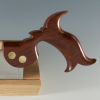
Originally Posted by
Mel Fulks

For some jobs ,especially where a small head is needed I think the slotted shaper cutters are still necessary. Yes, some are
scared of them, some don't know how to use them, liability issues keep the one company that still makes them from giving
Instruction. Modern shaper books have less info on them than the old thin book that was put out by delta. Some employers will let anyone do any type of work and expect good employees to use faulty and mis matched steel. I worked
for a company once that had over 500 knives that had been so abused that I took them home ,sorted them first by matching the steel, then by profile. Over 200 knives were too short, if matched in profile some had mismatched steel or
had been ground on edge to alter size. I made as much sense out of them as possible and threw away 200 knives that were worthless. I have been asked ,at times, by management to change a profile so that they won't have to buy more
steel. I absolutely refuse to do it.




 Reply With Quote
Reply With Quote

